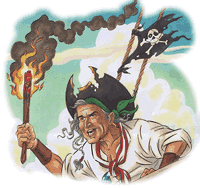 
In 1695 the British crown conferred upon one Capt'n W. Kidd a Letter of Marque to combat the increase of piracy in the Red Sea. As a privateer he also had the (British) right to take French ships. But Capt'n. W. Kidd turned himself into a pirate and in 1701, was hanged in London. As a deterrent, his tarred corpse hung over the Thames for months - easily visible to all who sailed by in their ships.
By this time Capt'n W. Kidd had been called one the worst pirates ever, although he had captured relatively few ships and was not nearly as brutal as many of his "colleagues". Henry Morgan, for example, was infamous for the cruel tortures of his victims. Thanks to his influential friends, however, he was thrown not into prison, but rather into the office of vice-governor of Jamaica.
In comparison Capt'n W. Kidd had made the step from "royal privateer to "common pirate' only unwillingly under pressure from his mutinous crew. His worst crime against the crown was probably the fact that he was relatively unsuccessful as a privateer and could not fulfill the expectations of his British investors. Finally, - although unwittingly - he even captured a British ship.
Pirates, Privateers, Investors
In 1695 the New York colonial official and ambitious entrepreneur Robert Livingston proposed that the then commercial captain William Kidd be sent as a privateer to end the pirate nuisance in the Red Sea. The later governor of New York, Lord Bellamont, pitched this proposal to the investors: four of the most powerful men in Britain, who from the outset planned to remain anonymous, with Bellamont put forward as the straw man. Among them were the Lord Keeper of the Great Seal and the First Lord of the Admiralty. The investors were responsible for 80% of the costs and therefore claimed the lion's share of the expected booty. Since the king usually received 10% from all privateering and Livingston and Kidd also claimed a portion for themselves, not even 25% remained for the entire crew.
At that time however, the "local tariff" on privateers was about 60%.
In contrast, aboard the ships of the lawless pirates, the entire booty was divided, whereby some crew members received a little more, according to their positions.
However, the pirate captain did not even receive any more than a double portion, which, by the way, could even be voted down. Unlike the navy, there were also remunerations for injuries and disability.
On the other hand, pirates, were constantly exposed to pursuit as outlaws, had thereby fewer chances to take provisions on board and were thus more likely than other sailors to be affected by diseases. The pirate life was still rather attractive however, because of the chance for booty, the absence of hierarchy and the somewhat cruel treatment for many sailors on warships.
In London Capt'n W. Kidd had therefore selected 70 reliable men for his privateer, the Adventure Galley, with nary a danger that they too would became pirates.
However, right at the beginning of his voyage he was forced to exchange many of them for rejects from the Royal Navy who had proven unfit for military service.
In order to finance the provisions for the journey to the Indian Ocean, Kidd captured a French fishing vessel in the Atlantic and sold it in New York, where he supplemented his crew to the desired strength of 150 men.
Since in the American colonies trade with pirates was carried on eagerly, in New York it was difficult to sign up sailors to fight for little money against pirates. Kidd saw himself forced to increase the crew's share of the profits to 60%. He omitted informing his backers about this and was now obligated to deliver 130% of his booty all told...
The Privateering Voyage
After five months Kidd reached Madagascar, the pirate island, without having boarded a single ship. Then he lost 50 men to illness on the Comoros Islands. By the time a year had passed, Capt'n W. Kidd had still taken neither a French nor a pirate ship. Among his crew loud voices urged casting their lot with piracy. So Capt'n W. Kidd's ship lay on the lookout at the entrance to the Red Sea until finally a convoy passed. Some of the ships sailed under British or Dutch flags, none were French or pirates. Capt'n W. Kidd secretly followed the convoy and tried to capture a Moorish ship. Taking a Moorish ship was no doubt also piracy, but was not always punished. For captains of Christian privateers they counted as easy booty. But Capt'n W. Kidd had bad luck: the Adventure Galley was driven off by one of the well-armed convoy escorts.
He sailed on to India, where he boarded another Moorish ship. He forced its British captain to work as a pilot on his ship. A few months later a cargo ship came into view, the crew looked forward to a fat booty. But soon it was discovered that the Loyal Captain flew the flag of Britain. Capt'n W. Kidd refused to attack the ship so the crew began a mutiny, which failed. In the course of a mighty struggle, Capt'n W. Kidd killed his cannon master, who had declared strongly in favor of taking the British ship. This act, committed in anger, would later bring him a guilty verdict for murder in the Old Bailey, the highest criminal court in all Britain.
With the next ship Capt'n W. Kidd seized on a ruse. He raised the French flag and also arranged for the captain of the other ship to do the same. Aboard the Adventure Galley the Dutch captain showed a French passport, at which Capt'n W. Kidd declared the ship a legitimate British prize. As was usual at that time the captain possessed passports of several different countries. The ship actually belonged to an Indian owner and thus was not thus approved by the British crown for privateering.
Capt'n W. Kidd used the same trick a couple months later to capture the Quedah Merchant. The British captain of this richly laden merchant hid himself and sent his French cannon master to pose as captain.
When a few days later the identity of the British captain was revealed, Capt'n. W. Kidd wanted to return the ship, his crew prevented him from doing so by. Kidd's proposal that they capture the ship of the former privateer and now pirate Robert Culliford was greeted only with mockery. Once again mutiny arose and most of the men went over to Culliford; Kidd capitulated. The cargo of the Quedah Merchant apportioned out, Kidd receiving the 40% usual to privateers instead of the 2 portions usual with pirates.
The Return of Cap'tn W. Kidd
By now the Royal Navy was after Kidd. He had to reckon with arrest in every port in the Colonies. His financiers, members of the ruling Whig party, came under pressure in Parliament on account of the scandal and dissociated themselves from him. Nevertheless, Kidd sailed back to New York where he hoped for the protection of his influential friends, in particular, Lord Bellamont. Meanwhile he had hidden the ill-gotten treasure in various places, planning to use it as leverage. He intended to prove his innocence with the French passports as evidence. Via an intermediary he sent the passports to Lord Bellamont. However, a few days after his arrival he was arrested in New York, Bellamont himself having him placed in irons.
During the London court hearing the French passports disappeared, only to emerge again over 200 years later in the British State Archives. The witnesses for the prosecution were two crew members, who had deserted in Madagascar. Thus Captain W. Kidd was several times condemned to death by hanging for the murder of the cannon master and for piracy. The heavyweight Kidd was effectively hung twice, since the first time the cord broke.
Numerous legends have sprung up since around Captain W. Kidd's treasure. He had hidden a large portion of it on Gardiner's Island off Long Island. By order of Lord Bellamont these silk goods, jewels, gold and other forms of wealth were dug up and seized on behalf of the crown. Among other things a treasure map in Capt'n W. Kidd's handwriting led to further speculation which inspired the famous Robert Louis Stevenson novel, Treasure Island.
Sources:
Douglas Botting and the editors ofTime-Life Books, The Piraten, Bechtermünz Verlag GmbH 1992
as well as some german web pages
Translation: Rick Heli
|






